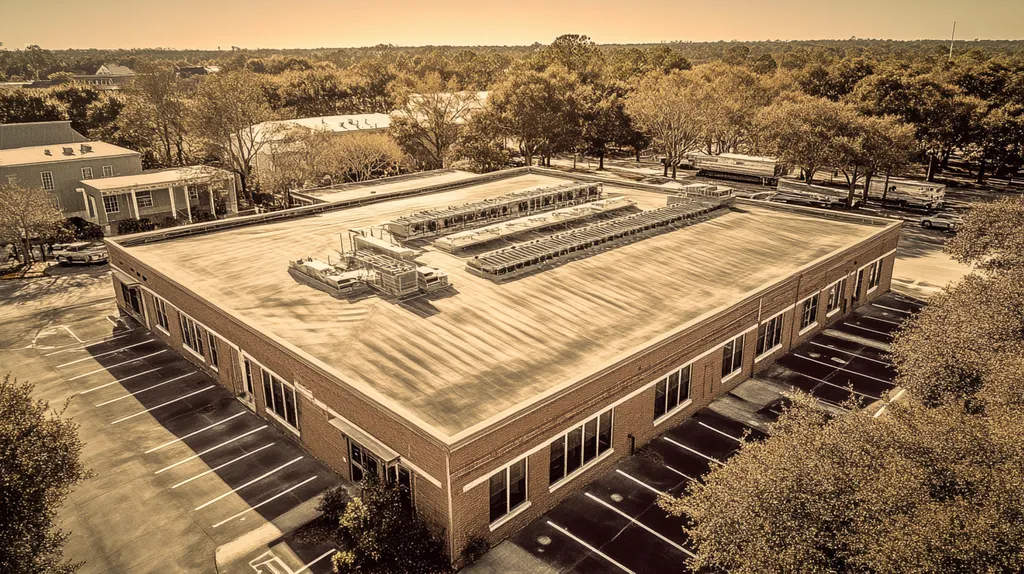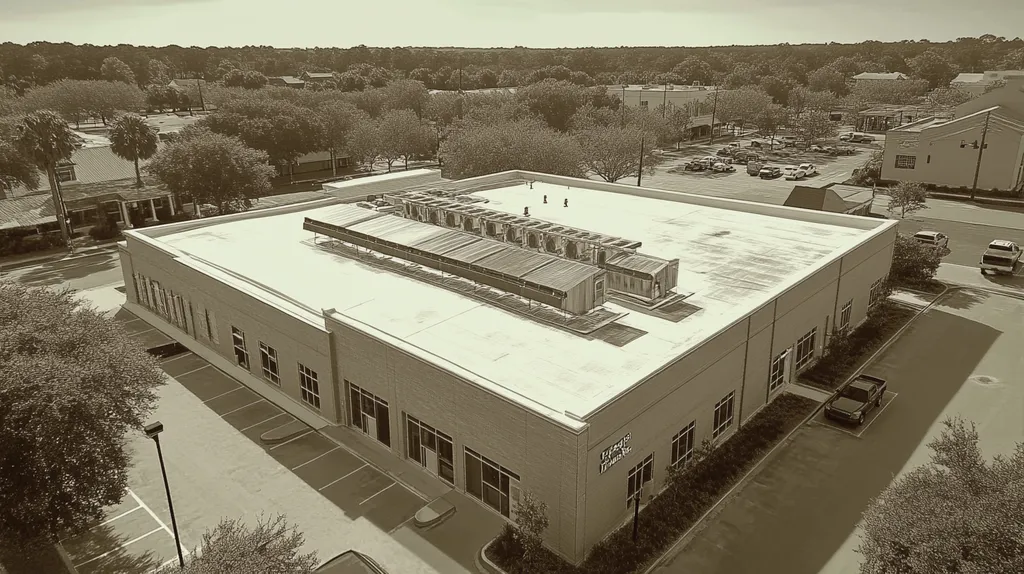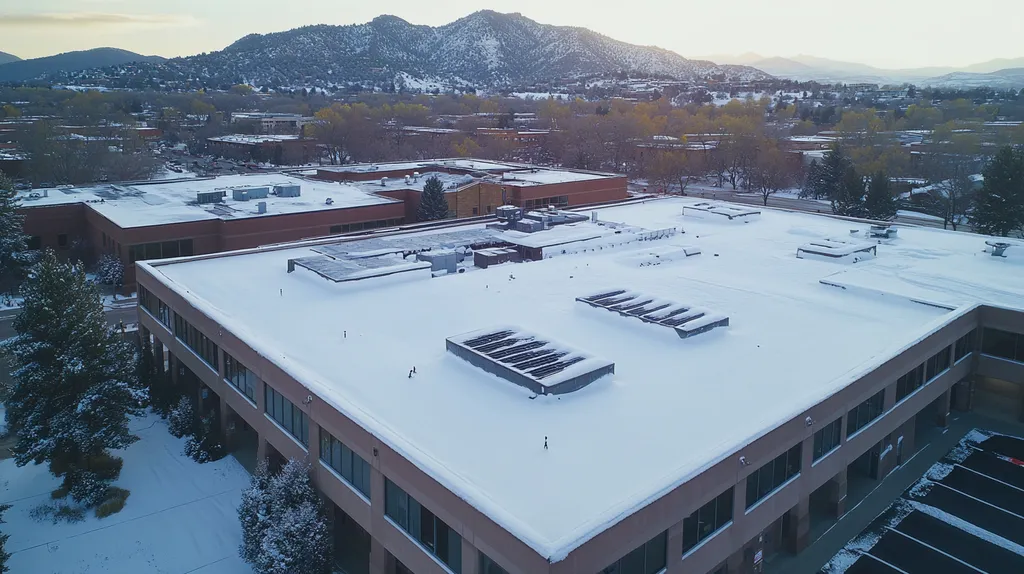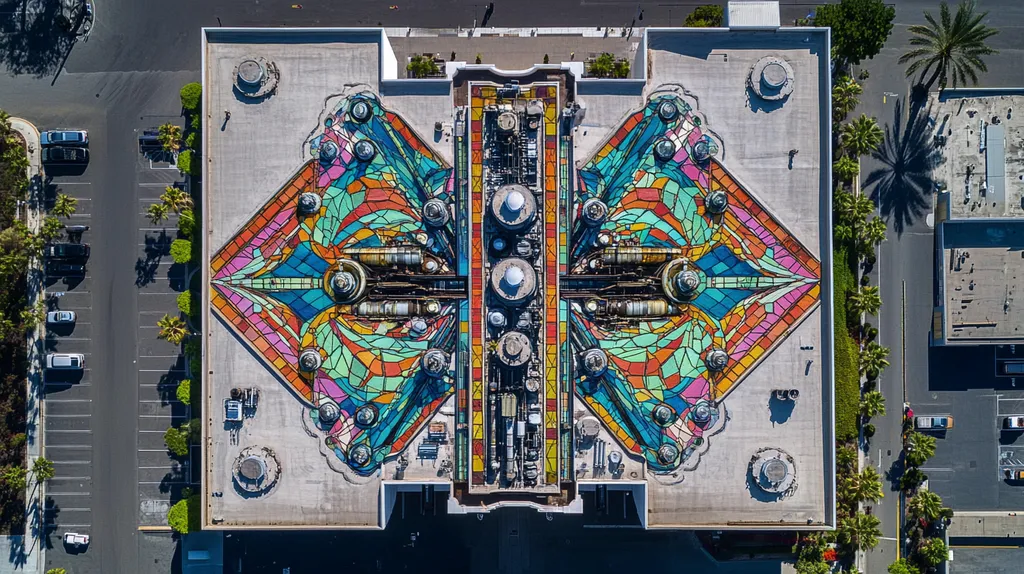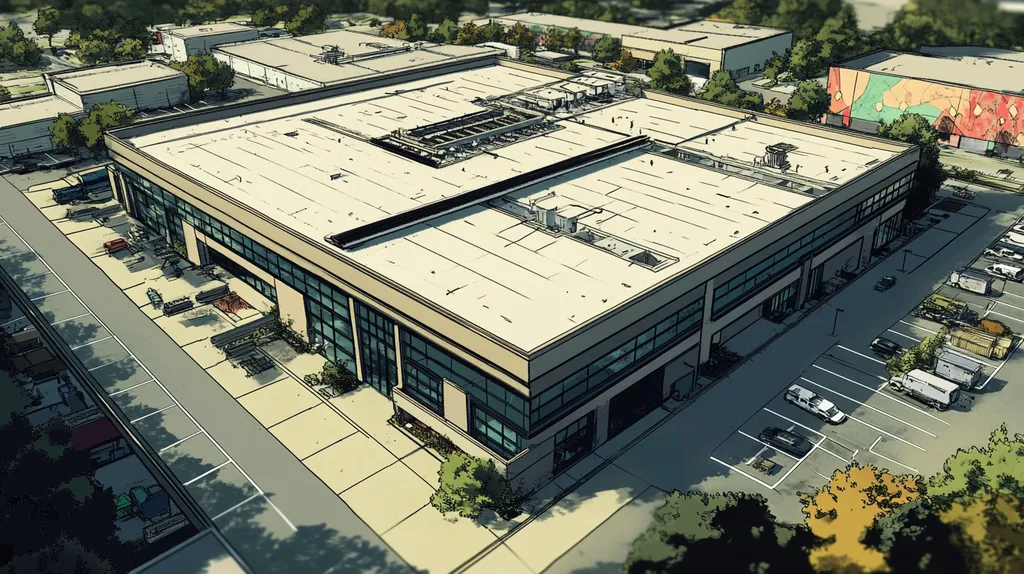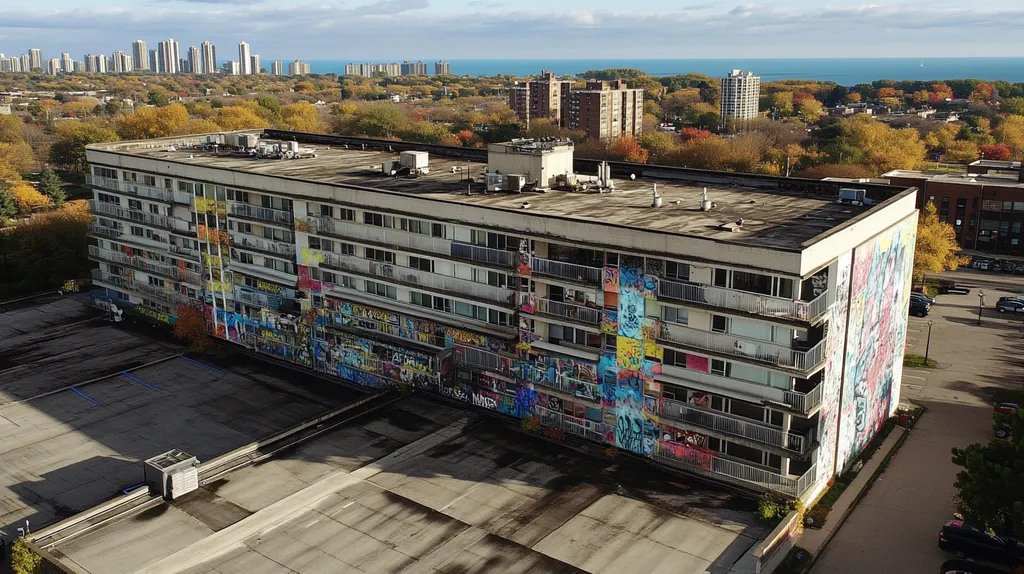Rising energy costs are forcing industrial facilities to confront a stark reality: up to 40% of their cooling expenses stem from inefficient roofing systems. Modern coating technologies can slash these costs by reducing roof surface temperatures up to 60°F, yet many facilities continue to operate with outdated solutions.
As environmental regulations tighten and utility rates climb, facility managers must understand how advanced coating systems optimize energy performance through enhanced reflectivity, controlled heat transfer, and strategic implementation.
This comprehensive guide examines the science behind energy-efficient roof coatings, exploring critical aspects from material selection and application methods to maintenance protocols and performance metrics that drive measurable cost savings.
SECTION 1: FUNDAMENTAL CONCEPTS
As energy costs continue to rise, industrial facilities face mounting pressure to optimize their building efficiency. Roofing systems represent one of the largest opportunities for energy conservation, with proper coating solutions capable of dramatically reducing cooling loads and operating expenses. Understanding the science behind roof coatings and their impact on building performance has become essential for facility managers seeking to control costs while meeting increasingly stringent environmental standards.
Principles of Reflectivity and Emissivity in Roof Coatings
Cool roofs equipped with advanced coatings can maintain temperatures up to 60°F cooler than conventional black roofs during peak summer conditions. These dramatic improvements stem from the coating’s ability to reflect incoming solar radiation while efficiently releasing absorbed heat. (source: U.S. Department of Energy)
Reflectivity represents the percentage of solar radiation bounced away from the roof surface. Modern coating technologies can achieve initial solar reflectance values above 85%, significantly reducing heat absorption into the building envelope.
Emissivity measures how effectively the roof surface releases absorbed heat back into the atmosphere. High-emissivity coatings help maintain lower roof temperatures even after sunset by radiating accumulated heat away from the building.
The combination of high reflectivity and emissivity creates a powerful cooling effect. This reduces the strain on HVAC systems while improving indoor comfort and extending the roof’s service life.
Thermal Dynamics and Roof Energy Transfer Mechanisms
Heat transfer through commercial roofing occurs through three primary mechanisms: conduction, convection, and radiation. Understanding these processes helps facility managers select appropriate coating solutions.
Conductive heat transfer moves thermal energy directly through roofing materials. Specialized coating formulations create thermal barriers that restrict this flow, reducing heat gain during hot periods.
Convective transfer involves heat movement through air currents across the roof surface. Properly applied coatings maintain more stable surface temperatures, minimizing disruptive thermal currents.
Radiative transfer represents the most significant source of roof heat gain. Advanced coating technologies specifically target this mechanism by reflecting incoming solar radiation before it can be absorbed into the roofing system.
Environmental Impact and Regulatory Standards in the U.S.
Federal guidelines now require many commercial buildings to meet specific energy performance targets. Cool roof products must achieve minimum solar reflectance values of 0.50 after three years of weathering to qualify for ENERGY STAR certification.
Local building codes increasingly mandate energy-efficient roofing solutions, particularly in urban areas fighting the heat island effect. Many jurisdictions offer tax incentives and rebates for installing qualified cool roof systems.
The growing focus on environmental impact has led to stricter standards for coating durability and performance. Manufacturers must now verify their products’ long-term effectiveness through standardized testing protocols.
Meeting these evolving regulations requires careful selection of coating systems backed by documented performance data. This ensures compliance while maximizing potential energy savings and environmental benefits.
SECTION 2: SYSTEM COMPONENTS
The industrial roofing sector faces unprecedented challenges in energy management. Modern coating systems represent a critical opportunity to dramatically reduce facility operating costs while meeting sustainability goals. Understanding the interplay between coating materials, substrate preparation, and performance-enhancing additives is essential for maximizing energy efficiency investments and extending roof service life.
Types of Energy-Efficient Roof Coating Materials
Cool roof products tested through standardized rating programs can maintain temperatures up to 60°F cooler than traditional black roofs during peak summer conditions, delivering significant reductions in cooling energy consumption. (source: U.S. Department of Energy)
Acrylic coatings offer excellent UV resistance and reflectivity, making them ideal for exposed roof surfaces. Their water-based formulation provides easy application and maintenance while delivering strong adhesion to most substrates.
Silicone coatings excel in extreme temperature conditions and provide superior waterproofing capabilities. Their molecular structure resists degradation from UV exposure, helping maintain reflective properties over time.
Polyurethane systems combine high durability with excellent chemical resistance. Available in both aromatic and aliphatic formulations, they can be engineered for specific performance requirements while maintaining strong reflective properties.
Substrate Compatibility and Surface Preparation
Proper substrate evaluation determines coating system success. Different roofing materials require specific surface treatments and primer systems to ensure optimal coating adhesion and performance.
Metal roofs demand thorough rust removal and chemical treatment of any remaining oxidation. Proper neutralization of surface treatments ensures long-term coating stability and prevents premature failure.
Single-ply membrane surfaces require careful cleaning to remove accumulated dirt and biological growth. Manufacturer-approved cleaning agents help prevent damage to the base membrane while ensuring proper coating adhesion.
Built-up and modified bitumen roofs often need specialized primers to prevent bleed-through and maintain coating reflectivity. Surface roughness must be evaluated to determine proper coating thickness requirements.
Additives and Pigments Enhancing Reflectivity and Durability
Advanced ceramic microspheres create additional reflection points within the coating matrix. This technology enhances total solar reflectance while providing improved insulation properties.
Zinc oxide and titanium dioxide additives deliver superior UV protection while maintaining high reflectivity. These materials help prevent coating degradation and extend service life in intense sun exposure.
Specialized crosslinking agents improve coating flexibility and impact resistance. This enhanced durability helps maintain energy efficiency benefits even under challenging industrial conditions.
Anti-microbial additives prevent biological growth that can reduce reflective properties over time. Regular maintenance combined with these additives helps preserve optimal energy performance throughout the coating lifecycle.
SECTION 3: IMPLEMENTATION METHODS
Energy-efficient roof coatings represent a critical investment for industrial facilities, with proper implementation directly impacting long-term performance and cost savings. While the technology exists to dramatically reduce cooling costs, installation quality determines whether these benefits are fully realized. Successful coating projects require meticulous attention to application techniques, stringent safety protocols, and comprehensive quality testing to ensure optimal energy performance.
Application Techniques for Uniform Coating Thickness
Uniform coating thickness stands as the cornerstone of energy-efficient performance. Each mil of coating thickness must be carefully controlled to achieve specified thermal properties and ensure consistent reflectivity across the entire roof surface.
Spray application methods typically provide the most consistent results for large industrial surfaces. Equipment calibration and proper spray patterns help maintain uniform mil thickness while maximizing application efficiency.
Environmental conditions significantly impact coating performance. Application should occur when surface temperatures range between 50-90°F, with relative humidity below 85% to ensure proper curing and adhesion.
Quality control during application requires continuous monitoring with wet film thickness gauges. Regular measurements help identify variations before they become permanent defects that could compromise energy efficiency.
Safety and Environmental Controls During Installation
Safe installation practices protect both workers and building occupants. Full respiratory protection must be provided when applying atomized coatings, along with appropriate fall protection systems for elevated work.
Ventilation requirements vary based on coating chemistry and application method. Industrial facilities should maintain negative air pressure in work areas to prevent vapor migration into occupied spaces.
Material containment systems prevent environmental contamination during application. Proper planning includes spill prevention measures and appropriate disposal protocols for coating containers and cleanup materials.
Weather monitoring becomes essential for outdoor applications. Wind speed and direction must be tracked to prevent overspray damage while ensuring worker safety on elevated surfaces.
Quality Assurance: Testing Adhesion and Coverage
Adhesion testing confirms proper bonding between coating layers and substrates. Standard pull tests should achieve minimum values specified by coating manufacturers, with results documented for warranty compliance.
Coverage verification requires both visual inspection and instrumental measurement. Digital thickness gauges provide precise readings to verify specified dry film thickness across the entire roof surface.
Thermal imaging helps identify variations in coating performance. Infrared scans can detect areas of inconsistent thickness or poor adhesion that might compromise energy efficiency.
Documentation of testing procedures and results provides critical baseline data. This information supports warranty claims while establishing benchmarks for ongoing maintenance and performance monitoring.
Regular inspections throughout the coating’s service life help maintain optimal performance. Scheduled evaluations can identify areas requiring touch-up before energy efficiency becomes compromised.
SECTION 4: MAINTENANCE REQUIREMENTS
Energy-efficient roof coatings represent a significant investment that demands proper maintenance to deliver long-term value. Without regular upkeep, these systems can lose up to 50% of their reflective properties within the first two years, dramatically reducing energy savings. Proper maintenance protocols not only preserve coating performance but also protect the substantial financial investment made in these systems while ensuring continued reduction in cooling costs.
Inspection Protocols for Coating Integrity and Performance
Cool roofs stay up to 60°F cooler than traditional dark roofs, making regular inspections crucial for maintaining this performance advantage. Quarterly visual assessments should examine surface conditions, paying special attention to areas prone to ponding water or mechanical damage. (source: U.S. Department of Energy)
Document all inspections using standardized checklists that track coating thickness, reflectivity measurements, and surface deterioration. This creates a performance history that helps identify trends and predict maintenance needs.
Thermal imaging during peak sunlight hours can reveal areas where coating effectiveness has diminished. These scans highlight sections requiring immediate attention before energy efficiency becomes severely compromised.
Schedule professional assessments annually to verify coating performance meets specified requirements. These evaluations should include adhesion testing and reflectivity measurements using calibrated equipment.
Cleaning Procedures to Preserve Reflective Properties
Surface cleanliness directly impacts energy performance. Schedule washing sessions during moderate temperatures to prevent thermal shock to the coating system.
Use low-pressure washing equipment with fan tips to prevent coating damage. Water pressure should not exceed 1000 psi for most applications.
Apply only manufacturer-approved cleaning solutions that won’t degrade the coating surface. Allow adequate dwell time for cleaners to break down contaminants before rinsing.
Remove all standing water after cleaning to prevent mineral deposits from forming. These deposits can reduce reflectivity and create areas of increased heat absorption.
Repair Techniques: Addressing Cracks, Blisters, and Wear
Address surface defects immediately to prevent coating failure. Small cracks require proper cleaning and priming before applying compatible repair materials.
Cut and remove blistered areas back to sound coating. Allow the substrate to dry completely before applying patch materials in multiple thin layers.
Maintain coating thickness during repairs to ensure consistent thermal performance. Use wet film gauges to verify proper material application.
Document all repairs with photographs and detailed descriptions. This information helps track problem areas and plan future maintenance activities.
Test repaired areas for proper adhesion and reflectivity once materials have fully cured. This ensures repairs maintain the system’s energy-efficient properties.
SECTION 5: PERFORMANCE METRICS
Industrial roofing investments demand concrete performance data to justify their costs. Modern coating systems can reduce peak roof temperatures by up to 60°F, but achieving these benefits requires precise measurement and ongoing validation. Understanding key metrics helps facility managers optimize their energy efficiency investments while avoiding costly mistakes in system selection and maintenance.
Measuring Solar Reflectance and Thermal Emittance
Solar reflectance and thermal emittance values determine a roof’s surface temperature and cooling performance. These metrics must be evaluated using aged values rather than initial readings to accurately predict long-term energy savings. (source: Lawrence Berkeley National Laboratory)
Standard testing protocols measure solar reflectance on a scale from 0 to 1, with higher values indicating better heat reflection. Premium coating systems typically achieve initial readings above 0.85, though these values decrease with weathering and contamination.
Thermal emittance testing evaluates how effectively surfaces release absorbed heat back into the atmosphere. Most high-performance coatings maintain emittance values above 0.85, ensuring rapid heat dissipation during evening hours.
Regular field testing using calibrated equipment helps verify ongoing performance. Quarterly measurements identify areas requiring maintenance before degradation significantly impacts energy efficiency.
Evaluating Energy Savings and ROI on Coated Roofs
Energy savings calculations must account for multiple variables including local climate, utility rates, and existing insulation levels. Facilities with minimal insulation often see the greatest benefit from reflective coatings.
Initial coating investments typically range from $2-5 per square foot, depending on system complexity. Premium materials deliver faster payback through superior durability and sustained performance.
ROI calculations should include both direct energy savings and indirect benefits like extended roof life. Many facilities recover their coating investment within 3-5 years through reduced cooling costs alone.
Utility incentives and tax benefits can significantly improve project economics. Many jurisdictions offer rebates exceeding $0.50 per square foot for qualifying cool roof installations.
Longevity and Weather Resistance Benchmarks
Weather resistance testing evaluates coating performance under accelerated aging conditions. Quality systems maintain at least 80% of their initial reflectivity after 2000 hours of exposure.
Impact resistance becomes critical in areas prone to hail or maintenance traffic. Premium coatings resist puncture and maintain their protective properties even after moderate impact events.
Adhesion testing verifies long-term coating stability. Pull-test values should exceed 200 psi for most industrial applications, with minimal variation across the roof surface.
Chemical resistance protects against industrial pollutants and cleaning compounds. Coating systems must withstand repeated exposure to typical rooftop contaminants without degradation.
SECTION 6: OPTIMIZATION STRATEGIES
The industrial roofing sector wastes millions in energy costs annually through suboptimal coating implementations. While cool roof coatings can reduce surface temperatures by up to 60°F, achieving maximum efficiency requires strategic integration with other building systems. Modern coating solutions, when properly optimized, create synergistic effects that multiply energy savings while extending roof lifespans. Understanding these optimization strategies has become crucial as facilities face mounting pressure to reduce operating costs and meet sustainability targets.
Integrating Coatings with Insulation and Ventilation Systems
Maximizing coating performance requires careful coordination with existing insulation and ventilation components. R-20 insulation combined with high-performance coatings provides optimal thermal resistance in most U.S. climate zones. (source: Lawrence Berkeley National Laboratory)
Proper ventilation systems prevent moisture accumulation that can degrade coating performance. Air gaps between insulation layers promote convective cooling while reducing condensation risks that threaten coating adhesion.
Strategic placement of roof vents enhances coating effectiveness by removing trapped heat. This reduces thermal loading on both the coating system and underlying insulation materials.
Coordinated maintenance schedules for all roofing components help preserve system efficiency. Regular inspections should evaluate coating condition alongside insulation compression and ventilation blockages.
Selecting Coating Types for Specific Climates and Roof Types
Climate conditions fundamentally impact coating selection and performance requirements. Hot, sunny regions benefit most from high-reflectivity coatings, while moderate climates may prioritize moisture resistance over solar reflection.
Different roofing substrates demand specialized coating formulations. Metal roofs require products with superior adhesion and flexibility, while single-ply membranes need coatings that won’t degrade the underlying material.
Local weather patterns influence application timing and curing requirements. Humidity levels, temperature ranges, and precipitation forecasts must align with coating specifications to ensure proper film formation.
Urban environments often require enhanced dirt-resistance properties to maintain reflectivity. Anti-microbial additives become crucial in areas prone to biological growth that can compromise coating performance.
Advanced Technologies and Innovations in Energy-Efficient Coatings
Phase-change materials incorporated into coating formulations actively regulate surface temperatures. These compounds absorb excess heat during peak conditions and release it during cooler periods.
Self-cleaning nanotechnology reduces maintenance requirements while preserving reflective properties. Hydrophobic surfaces shed contamination during rainfall, maintaining optimal energy performance between scheduled cleanings.
Smart coating systems with embedded sensors monitor performance metrics in real-time. This technology enables predictive maintenance by identifying areas of degraded efficiency before visible damage occurs.
Photocatalytic additives break down airborne pollutants while maintaining high reflectivity. These innovations deliver environmental benefits beyond energy savings, supporting broader sustainability initiatives.
Moving Forward
With energy costs projected to rise 30% over the next decade, industrial facilities can no longer afford inefficient roofing systems that waste cooling dollars.
Modern coating technologies offer a proven path to slash roof temperatures by up to 60°F while reducing HVAC loads by as much as 40%.
Success requires careful attention to material selection, proper application techniques, and regular maintenance protocols that preserve reflective properties.
As regulations tighten and sustainability demands increase, facilities that fail to optimize their roof coating systems risk falling behind competitors while paying an increasingly steep price in wasted energy costs.
The tools and technologies exist today – implementation simply requires commitment to best practices and a systematic approach to energy efficiency.
FREQUENTLY ASKED QUESTIONS
Q. What is the benefit of coatings for commercial roofs?
A. Coatings help reduce cooling loads and operating costs significantly. They reflect solar radiation and emit heat effectively, ultimately protecting the building’s structure and improving comfort indoors.
Q. What types of coatings are best for industrial roofs?
A. Acrylic, silicone, and polyurethane coatings are popular choices. Each offers unique benefits like UV resistance, weather durability, and effective waterproofing to maximize energy efficiency.
Q. How do I ensure proper coating application on my industrial roof?
A. It’s vital to follow uniform application techniques for thickness and environmental conditions. Regular monitoring during application ensures the coating meets quality and reflectivity standards for efficiency.
Q. How often should I maintain coatings on commercial roofs?
A. Regular inspections are recommended at least quarterly. Proper maintenance preserves coating integrity, ensuring energy efficiency is sustained over the roof’s life, avoiding costly repairs down the road.
Q. What performance metrics should I track for my roof coatings?
A. Key metrics include solar reflectance, thermal emittance, and adherence. Regular testing can identify performance issues before they lead to significant losses in energy efficiency.
Q. How can I optimize roof coatings with my existing systems?
A. Coordinate insulation and ventilation strategies with your coating systems. This ensures maximum performance and energy savings, while also extending the lifespan of both the insulation and the roof coating.
Q. Are there any innovations in coatings for commercial roofs?
A. Yes, recent advancements include self-cleaning nanotechnologies and phase-change materials. These innovations enhance performance and reduce maintenance needs, thereby maximizing energy efficiency over time.

